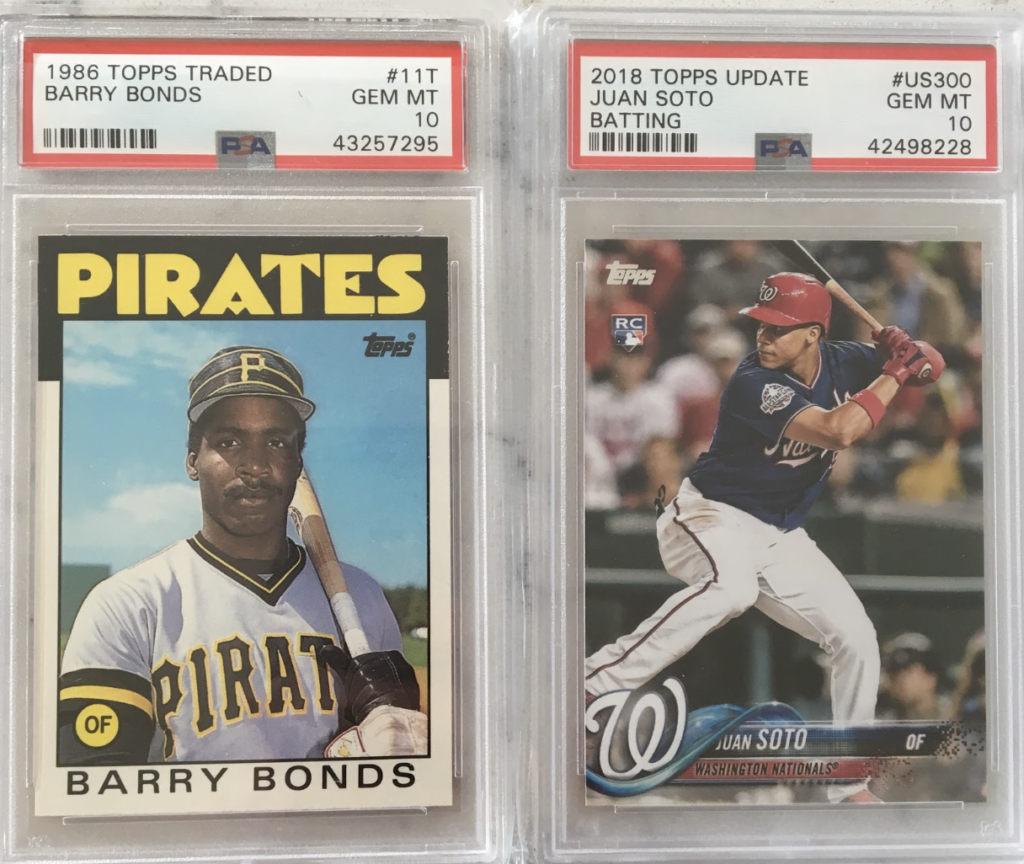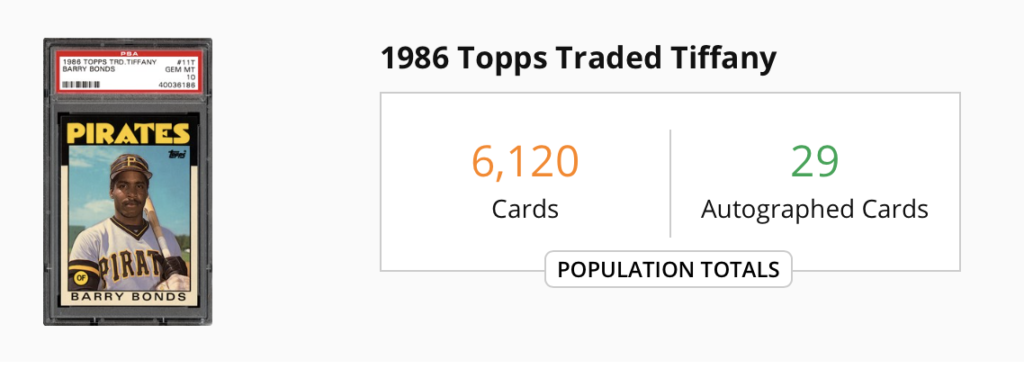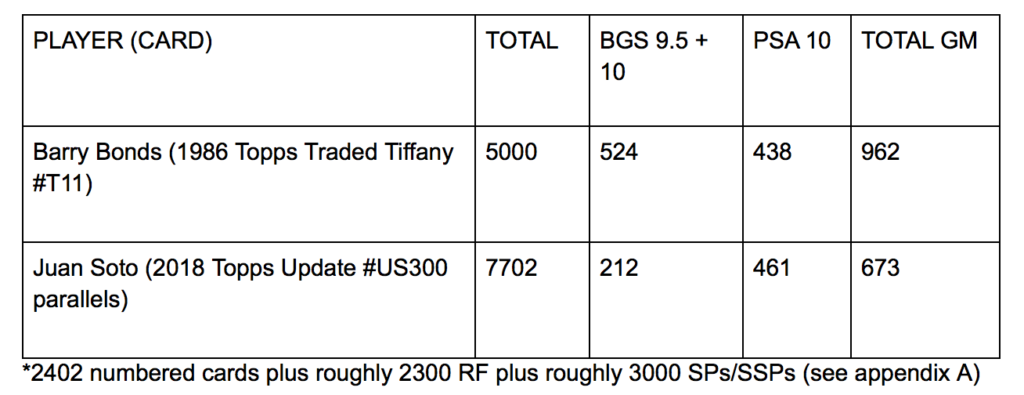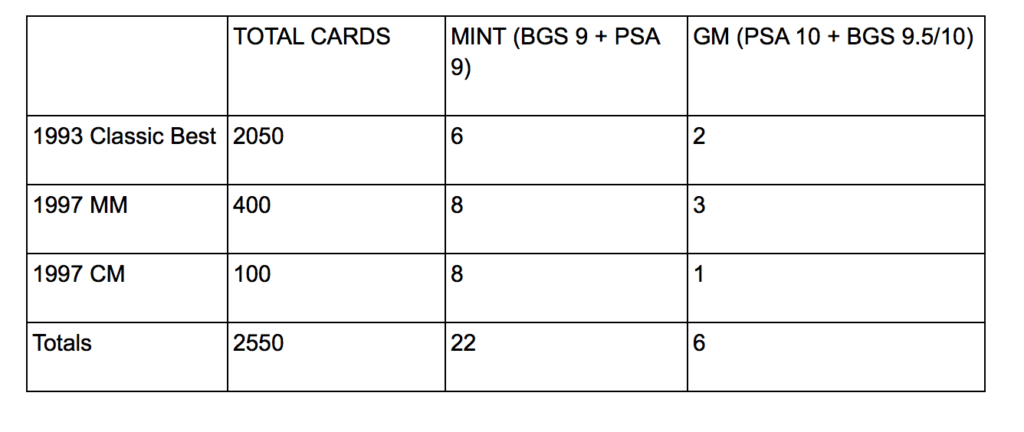
Sleight of Scarcity
This guest post came through our Article Submission Program. Thoughts and opinions are those of the author.
The baseball card collecting landscape is essentially unrecognizable today compared to the so-called ‘junk era’ when most of us originally fell in love with the hobby. This we know and actually tend to celebrate as present-day hobbyists. The most obvious difference, of course, is that we no longer have hundreds of millions of poorly printed base cards being produced every single year. Also noteworthy, however, and possibly just as important, is that we no longer have millions upon millions of casual baseball card collectors supporting the industry as we did during the junk era. Those millions of folks, of which I was one, did not chase the baseball cards that we modern collectors covet such as gem mint (GM) rookie cards (RCs), on-card autographs or parallels. Not really anyways. Instead, we stockpiled poor quality commons back then and were generally happy to do so.
[adcards]
Let us contrast this with 2019 – a time when the industry survives due to the relatively small number of passionate collectors and flippers who remain. For the most part, we have little interest in commons (especially poorly conditioned ones) unless of course they are scarce poorly conditioned commons from the 1960s or earlier. Given that the desires and demographics of modern-day card collectors has changed so drastically, I believe it is worth exploring which eras cards, the modern era or the so-called junk era, best suit the needs of those left standing in the hobby? Is it even possible that we have entered a new junk era? A new junk era where the types of cards modern collectors and flippers love are actually far more abundant than ever before?
As collectors and flippers, we crave scarcity. We particularly crave scarce RCs and early on-card autographed cards. Scarcity in card collecting, of course, is basically created one of the way ways:
1. Identifying near perfect/perfect, GM cards via professional grading services
2. Production of ‘parallel’ cards, which are different versions of the same card that have significantly lower print runs than the original base common
As such, graded GM base RCs, early on-card autos, and parallel RCs reign supreme in our current collecting universe. Dare I ask though, are they actually even scarce anymore? Are they even rare in relation to the dark old days of the junk era when seemingly nothing was scarce?
The obvious answer should be yes because baseball card print runs for base commons are far lower now than probably ever before. Topps doesn’t make 25 million base cards per player per set anymore, they probably make more like 100000. End of discussion right?
I am afraid it is not that simple. We know that in addition to the junk era print quality being terrible, on-card autographs and parallel cards were not commonly produced. This suggests that the number of junk era GM RCs, on-card autos and parallels might actually be relatively low compared to the modern era.
To find out, let us consider the population reports of Barry Bonds and Juan Soto baseball cards. These two players are very prominent members of their respective card collecting eras and should serve as a reasonable comparison for the topic at hand.
We begin with the most collectible RC of a player, which tends to be their first Topps flagship RC. For the uninitiated, a card is considered GM if it is graded 9.5 or greater by BGS or 10 by PSA. There are other grading companies but we will stick with the big daddies for the purposes of this article. Consider the table below:
TABLE 1 – Topps Flagship Base Rookie Cards for Barry Bonds and Juan Soto

Amazingly, there are already more graded GM Topps flagship Juan Soto RCs than there are graded GM Barry Bonds ‘junk era’ Topps flagship RCs. Considering how much unopened 2018 Topps Update product is still out there, how much wider might this gap grow? According to a 2018 Forbes article, there are no more unopened 1986 Topps Traded cases because one avid collector tracked them all down in order to rip them and grade all the Barry Bonds RCs worth grading.
This means that only the number of Juan Soto graded GM Topps flagship RCs will continue to grow in any appreciable way. It would not surprise me if by the time Juan Soto is retired he has at least twice as many graded GM Topps flagship RCs as Barry Bonds. Collectors and flippers are grading everything nowadays because there is a financial incentive to do so and because such a high percentage of modern-day cards are printed with GM quality.
How about Parallel RCs?

Let us now consider parallels because they are very popular among modern collectors due to their apparent scarcity. Numbered cards were not really a thing in 1986, but error cards and the severely limited print run ‘glossy finish’ sets such as Topps Tiffany were the ‘parallel’ cards of the junk era. Other than the 5000 set print run 1986 Topps Traded Tiffany set I do not think any other obvious parallels for Barry Bonds 1986 RCs exist. There are certainly some from 1987 that collectors chase including the 30000 print run Topps Tiffany cards, Fleer Glossy cards, and the Donruss Johnny Ray error cards. But do any other 1986 ‘parallels’ of his true rookie cards exist? Not that I can find. Sure, there are millions more 1986 Bonds base Donruss, Fleer Update and Topps Traded RCs in circulation then there is Juan Soto base RCs. But do collectors today really care how many extra millions of poorly centered, poorly printed Barry Bonds RCs are in circulation? I dare say that we do not because again, what we truly care about is scarcity people!
Let us consider the scarcity of each player’s Topps flagship RC parallels in the table below:
[adcards]
TABLE 2: Comparing Barry Bonds’ Flagship Topps Parallel RCs to Juan Soto’s

The numbers suggest that there are roughly 2700 more Juan Soto Topps flagship parallel RCs in circulation than Barry Bonds parallel Topps flagship RCs and also that Soto’s parallel RCs are catching up quickly in GM form.
In contrast to Barry Bonds though, how many 2018 baseball card sets other than Topps Update had parallel Juan Soto RCs in them? The answer would be basically every single set that was released that included a Juan Soto RC.
Let us consider one of those sets – 2018 Topps Chrome Update. It has 426 numbered Juan Soto RC parallels plus a non-numbered pink refractor parallel which has been submitted to PSA seven times more often than the /250 refractor. Based on this we can estimate that there are roughly seven times more pink refractors than the /250 refractors and thus add roughly 1750 pink parallels to the 426 numbered parallels. That would mean more than 2000 parallel Juan Soto RCs in Topps Chrome Update alone. This takes us to around 10000 total now between just the two 2018 Update sets. We haven’t yet considered the parallels from some of the other sets with a Juan Soto RC, including:
– Bowman’s Best
– Topps Archives, Topps Fire, Topps Heritage, and Topps Gallery
– Donruss and Donruss Optic
– Panini Prizm, Panini Spectra, Panini Illusions, and Panini National Treasures
Does 20000 total Juan Soto parallel RCs seem like an over-estimate? Not to me, and if this is even close to accurate that would mean that there are four times more parallel 2018 Juan Soto RCs than there are parallel 1986 ‘junk era’ Barry Bonds RCs. So far, in terms of scarcity, the junk era seems to be winning where it counts the most with modern collectors.
How about on-card autographs?
Autographed cards were not a big thing during the junk era so this is not exactly a fair comparison. In most cases, players signed 1000-2000 cards in the early 1990s with low-quality card manufacturers like Classic Best, Front Row, etc. Most then had their first professional-looking on-card autos produced by a major card manufacturer in either 1996 (Leaf Signature Series) or 1997 (Donruss Signature Series). Print runs varied considerably but tended to range between 500 to 5000 total on-card autos per player from 1996 to 1997.
Barry Bonds was no different. His first on-card auto was a 1993 classic best auto. The card quality was poor and it only sells for only $70-80 in ungraded and BGS 9 condition today.
His next on-card autograph card appeared in the awesome 1997 Donruss Signature Series set. He was a very exclusive signer and only put ink on 500 cards including 400 Millennium Marks cards and 100 Century Marks cards. Like the 1993 Classic Best auto, the number of graded GM versions of the 1997 auto card is incredibly low. Consider the table below:
TABLE 3 – Barry Bonds earliest on-card autographed cards:

As you can see there were only 2550 total Barry Bonds on-card autos printed during the first 12 years of his career. Only 6 of them total were graded GM as far as I can tell. The 1997 Donruss Signature Series autos sell very well (the most recent ungraded CM card sold was for $750) so investors and collectors have taken notice of this incredible scarcity. As well they should.
Let us now compare that to the current era of on-card autographs. Most players have multiple prospect auto cards before their MLB debut, none of which are more popular than their Bowman Chrome (BC) 1st auto. Juan Soto’s BC 1st auto was released in 2016 and has a print run that includes roughly 2250 base autos and 1239 parallel autos. Let’s consider the pop report for Juan Soto’s BC 1st autos in Table 4:
TABLE 4 – Juan Soto 2016 Bowman Chrome 1st autographed cards

In sum, there are over 1300 more GM Juan Soto BC 1st autos than there are total GM Barry Bonds on-card autos over the first 12 years of Bonds’ career. Here we are tripping over ourselves to drop $1300 on a base PSA 10 Soto BC 1st auto when the far more rare mint BGS 9 1997 Barry Bonds Century Mark autos are selling for $700. This seems a wee bit strange to me.
Lest we forget, Juan Soto’s BC 1st auto is not his only prospect auto card. Not even close. These sets all included a prospect auto card as well (with the number of them in brackets):
– 2016 Bowman International ink (100)
– 2016 Elite extra edition (1459)
– 2017 Bowman Chrome (51)
– 2017 Bowman Platinum (unknown amount of base auto’s plus 281 parallel autos)
So in addition to the roughly 3489 Bowman Chrome 1st autos Soto has at least another 2000 prospect on-card autos, plus an absolute ton of 2018 RC autos that, all told, easily put his total prospect plus RC autos north of 7500. Put another way, Juan Soto has at least 3 times as many on-card autos before his second season than Barry Bonds had through his first 12. Can you spot the junk era?
In conclusion, the only thing junky about the ‘junk era’ was the amount of terrible quality base cards that were printed. The was no scarcity to those. Since no one cares about poor quality base cards anymore (except collectors of 1960 and earlier cards since they are actually rare), perhaps we are all wrong about where the true junk era lies. In terms of what modern-day collectors really care about – high quality or graded GM base RCs, parallel RCs, and early on-card autographs, the so-called junk era has far superior scarcity than the modern era.
The only thing the modern era truly has going for it is there are far fewer base cards being printed than ever before and the print quality of these cards is excellent. I do wonder though – if Juan Soto’s Topps flagship RCs are so grade-able that he ends up with 20000 GM copies by the time he is a Hall of Famer plus 20000 various RC parallels, are collectors really going to prioritize his cards long term? How about the roughly 10000 early on-card autos he has when an alarming percentage of them are grading GM as well? Are those going to remain the object of collectors desire decades down the road, especially when he is adding thousands of additional on card autos every single year? I am not so sure. At this rate there just might be a premium Juan Soto card or two for everyone who cares about cardboard years before he even delivers his potential HOF speech. If so, this modern sleight of scarcity will not end well. Once scarcity goes, the party ends and the hangover is real for baseball card valuations.
For this reason, I am now almost exclusively targeting junk era (or earlier) GM RCs, GM parallel RCs, and early on-card autos for my personal collection (PC). I know what the supply for these cards is and what the demand for them is both now and likely will be in the future. Neither should really change much in a way that could potentially devastate valuations. As far as modern cards go, the numbers and the trends concern me, and for that reason, I am choosing mostly to only invest in them as a means of short term flipping in order to generate revenue for junk era PC purchases. In the words of an artist from the definite junk era of pop music, ‘How Bizarre?’
Chris from BigThreePC Baseball Cards
Appendix A: Rough math used to estimate the number of Rainbow Foil, SP and SSP cards in 2018 Topps Update
1. Estimating the number of Rainbow foil (RF) parallels:
We know the number of gold parallels is 2018. Let’s compare the pack odds of the two parallels:
RF: 1:10 Hobby Packs and 1:10 Retail packs
Gold: 1:11 Hobby packs and 1:10 Retail packs
Gold /2018 parallels are barely a harder pull than RF parallels so despite not being numbered we can probably assume that there is somewhere around only 5-10% more RF cards than gold cards. So I estimated that the number of RF parallels was around 2300 in 2018 Topps Update.
2. Estimating the number of Short Prints (SPs) and Super Short Print (SSPs)
Short Prints (SPs): 1:9 Jumbo packs 1:45 Hobby packs 1:37 Retail packs (52 card SP set)
SSPs 1:71 J 1:273 H (25 SSP card set)
Again, using the pack odds we compare the known quantity (golds) to unknown (SP):
Roughly 1 Gold per 10 Hobby/Retail packs vs 1 SP per 40 Hobby/Retail packs (1/4) but 300 different cards have gold parallels vs only 52 different cards in the SP set (300/52). This means that though pulling an SP card is 4 times rarer than pulling a gold parallel, with the SP set being so much smaller there are actually probably more SPs per player with an SP than there are gold parallels of that player’s RC. Mathematically I would estimate that 1/4 x 300/52 = 1.44 SPs per player with an SP vs their number of 2018 gold cards per RC.
The pop reports do not perfectly support my math however when looking at Juan Soto’s 2018 US cards:
BGS Gold vs SP submissions (95 Gold vs 53 SP)
PSA Gold vs SP submissions (223 Gold submitted vs 191 SP)
We need to allow for the fact though that many people do not even recognize an SP/SPP when they see one so I am inclined to believe what the math says – that there are at least as many Juan Soto SPs printed as there are Golds of his RC, probably a bit more. Based on the math there should be 2900 SPs but given the conflicting PSA/BGS date I settled on concluding that SPs are about as rare as an RF parallel (2300).
I used the same approach to estimate the number of 2018 Juan Soto Topps Update SSPs.
Roughly 1 Gold per 10 packs vs 1 SSP per 260 packs (1/26) but 300 cards have gold parallels vs 25 cards having SSPs (300/25) = 0.46 SSPs per gold. Again, the pop report for Juan Soto US RCs:
BGS Gold vs SSP submissions (95 Gold vs 29 SSP)
PSA Gold vs SP submissions (223 Gold submitted vs 59 SSP)
Here again, the pop report ratios reflect a different ratio than the math. It is not super far off though, suggesting a 0.28 SSP per gold ratio for Juan Soto. Using the middle ground between these two estimations would suggest that there are at least 700 Juan Soto SSPs.
TOTAL SP/SSP Juan Sotos – Roughly 3000 (but probably more if we believe the math).
Scarcity is something all collectors/investor seem to crave, does Chris’ scarcity model support that idea? Do you have a similar strategy to ascertain rarity in the market? Tell us in the Comments below.
Ready to take your sports card investing to the next level? Join my Membership Program now for card picks, analytics, premium community access and much more!






